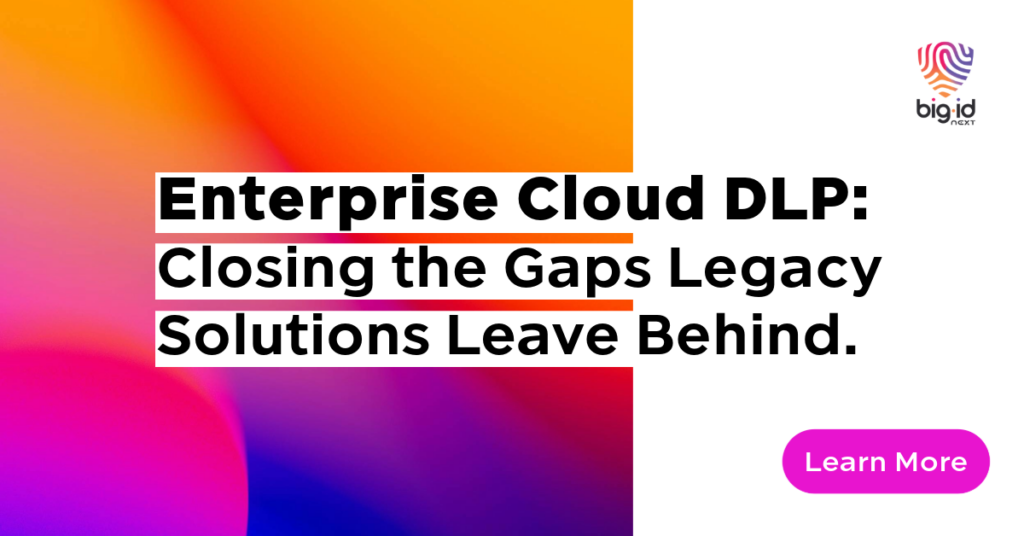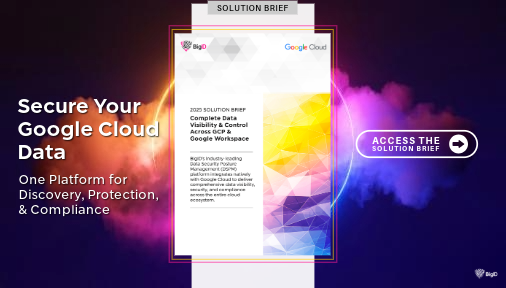Data Loss Prevention (DLP) was designed for an era of endpoints and on-prem infrastructure. Today, those tools are outdated. Proxy and agent-based DLP solutions still dominate the market, but they come with major trade-offs: high complexity, limited coverage, and an overwhelming volume of false positives.
Legacy DLP operates downstream, attempting to classify data in motion, often too late to act effectively. These deployments require constant maintenance, software agents that bog down performance, and rely on traffic rerouting that breaks in modern SaaS and cloud-native environments.
Traditional Data Loss Prevention (DLP) solutions, rooted in agent- and proxy-based architectures, struggle to address the complexities of modern data environments. They often result in high false positives, complex deployments, and inadequate coverage of cloud-native and SaaS platforms.
BigID: DLP Rebuilt for the Cloud
BigID delivers a new approach – one that starts with accurate data discovery and classification at the source. By combining agentless DSPM (Data Security Posture Management) with enforcement across native cloud platforms, BigID shifts DLP upstream to where risk originates.
Here’s how it works:
- Detect before data moves: BigID’s deep, context-aware discovery classifies sensitive data in place – before it’s exposed.
- Respond natively: Take action where data lives. Leverage native remediation capabilities within BigID to take action on risk, revoke permissions, delete data, and operationalize security controls.
- Interoperate with what you have: Integrate with legacy DLP and your entire ecosystem via labeling, tagging, and APIs to extend controls without recreating them.
The result is true cloud DLP – agentless, scalable, and tightly aligned with today’s hybrid and multi-cloud architectures.
The Limitations of Legacy DLP
- Agent and Proxy Challenges: Deployment complexities and performance issues arise from reliance on agents and proxies, which are often incompatible with cloud-native architectures.
- False Positives Everywhere: Without accurate classification at the source, most DLP policies flag the wrong things, causing alert fatigue and eroding trust in the system. Legacy systems frequently misclassify data in motion, leading to false positives that hinder business operations and false negatives that leave data vulnerable.
- Limited Cloud and SaaS Support: Traditional DLP tools are ill-equipped to handle data across cloud-native and SaaS platforms, resulting in convoluted rerouting requirements and security gaps.
- Too Little, Too Late: Policies trigger after data is already in motion or shared – and remediation is often too late or too blunt.
The Need for a Modern Approach
Gartner emphasizes investing in cloud-native DLP tools with comprehensive, adaptive data protection techniques, including content and contextual inspection capabilities, to effectively manage insider risks and gain better visibility and control over data in public cloud environments.
BigID: The Industry’s Most Complete Cloud DLP Platform
BigID revolutionizes DLP by focusing on data itself, offering unparalleled capabilities to detect, classify, and protect sensitive information across all environments. . As the pioneer in combining DSPM and DLP into one unified Data Security Platform, BigID offers unmatched capabilities to detect, classify, and protect sensitive data – everywhere it lives.
Key Differentiators
- Data Classification First: BigID employs ML-driven classification to accurately identify sensitive data at rest across cloud, SaaS, and hybrid environments, reducing false positives and ensuring effective policy enforcement.
- Data Activity Monitoring & Data Detection and Response (DDR): BigID provides real-time analysis of data usage, uncovering insider threats and policy violations before they escalate.
- Native Remediation and Deletion Capabilities: BigID enables organizations to remediate sensitive data directly within its platform, offering both centralized and decentralized workflows. With BigID’s native security controls, you can tag, label, delete, move, mask, revoke access, trigger workflows, and more at enterprise scale, streamlining compliance and risk mitigation efforts.
- Advanced Access Control and Least Privilege Enforcement: BigID facilitates the identification and remediation of overexposed data and overprivileged users, supporting the implementation of a zero trust architecture by ensuring users have access only to the data necessary for their roles.
- Best-in-Class Labeling & Tagging: BigID applies deep classification metadata, sensitivity labels, and usage tags automatically and consistently – powering downstream enforcement in Microsoft Purview, Google Workspace, and beyond.
- AI Intelligence and AI Security: BigID’s AI-driven approach not only identifies sensitive content but also safeguards AI models and pipelines from exposure and unauthorized training on risky data.
- Context-Aware Cross-Border Data Transfers: BigID understands data residency, ownership, and jurisdiction, enabling the enforcement of policies that prevent non-compliant data transfers and ensure adherence to global regulations.
- Controls at the Source: BigID secures data within databases, repositories, warehouses, and cloud storage, applying controls directly at the data layer to address gaps left by reactive edge tools.
BigID in Action: Cloud DLP for the Real World
Organizations leveraging BigID benefit from:
- Full Visibility: Comprehensive insights across all cloud, hybrid, and SaaS environments
- Accurate Detection: Precise identification of sensitive data and policy violations.
- Seamless Enforcement: Policy application through native cloud controls without the need for agents or rerouting.
- Interoperability: Integration with legacy DLP tools via APIs, labels, and automation.
- Unified Data Security: A cohesive foundation for data security initiatives, encompassing compliance, governance, and AI risk management.
BigID’s approach transforms DLP, delivering the only Cloud DLP solution built for the complexities of modern data environments – see it in action today.


